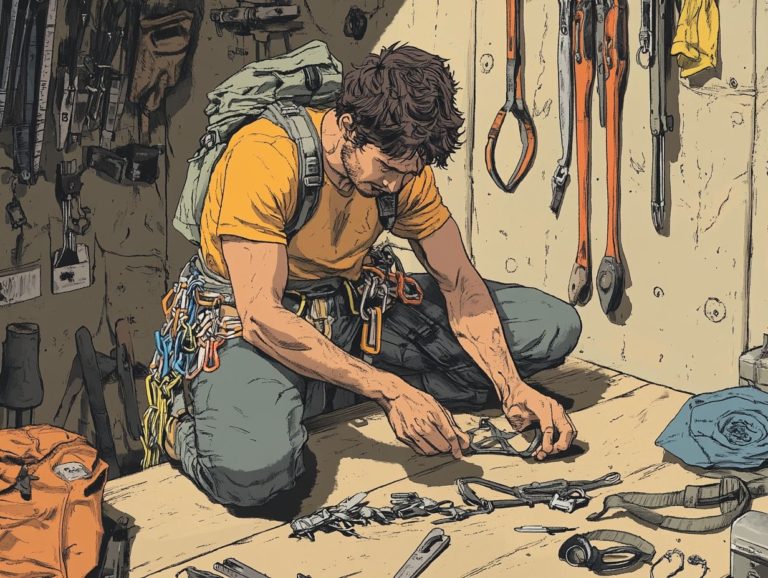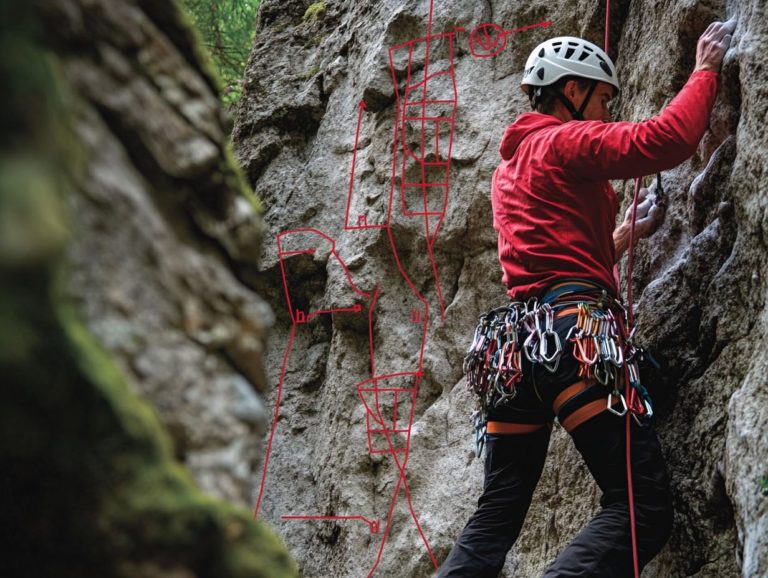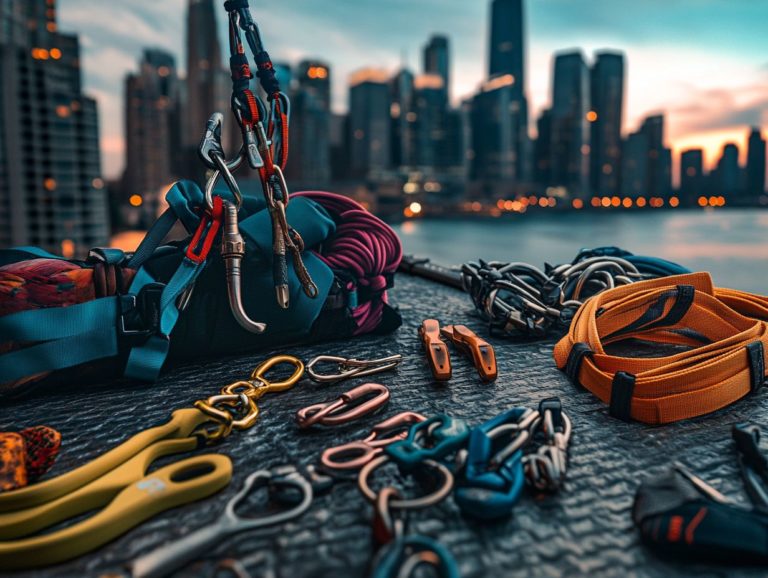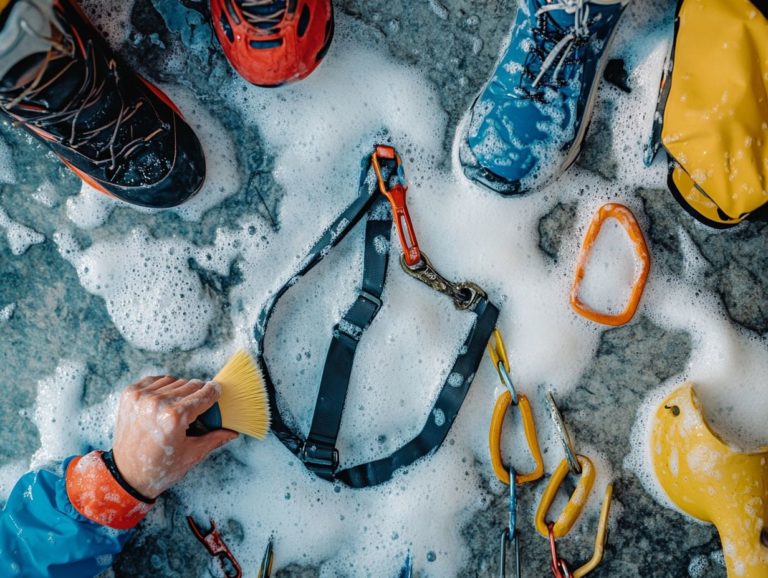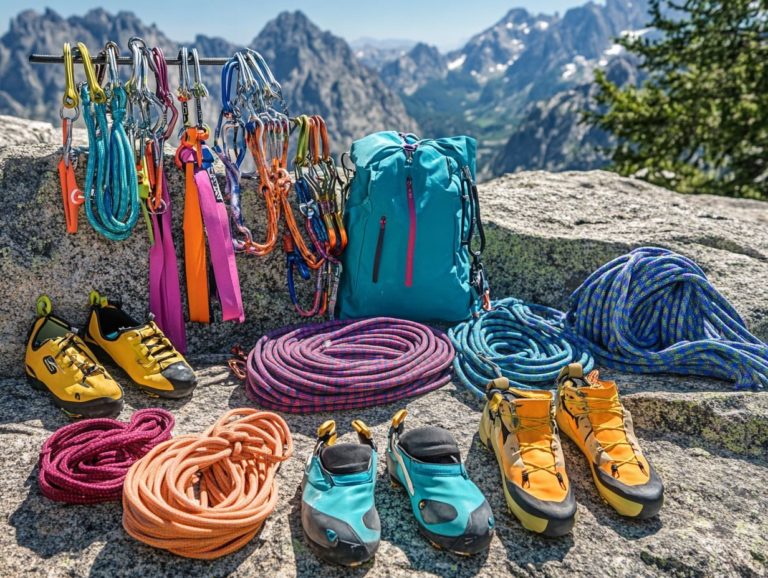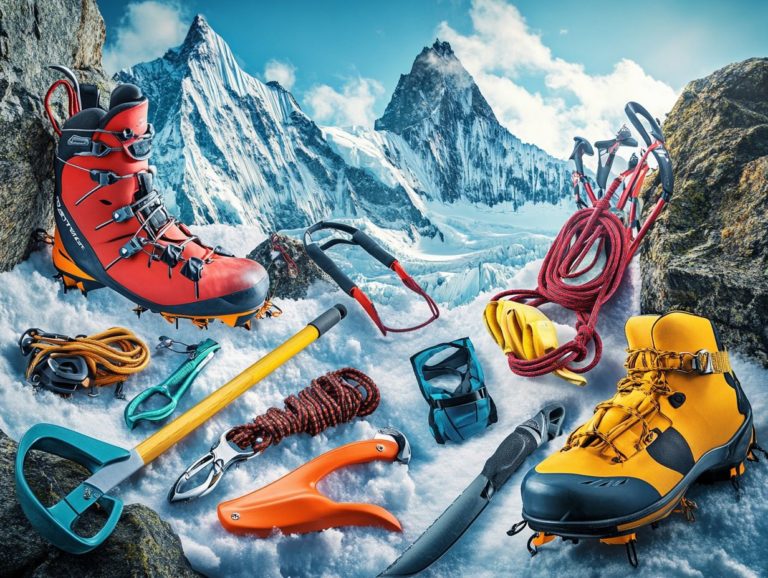Understanding the Costs of Climbing Gear
Climbing is an exhilarating pursuit, and having the right gear can mean the difference between an unforgettable adventure and a dangerous situation.
Investing in top-notch climbing equipment not only enhances your safety but also boosts your performance, allowing you to reach new heights with confidence.
In this article, you ll discover essential types of climbing gear you need, along with the factors that influence their cost and smart budgeting tips to keep your wallet happy.
You’ll also find a thoughtful examination of the pros and cons of purchasing new versus used gear, empowering you to make informed choices for your climbing journey.
Contents
- Key Takeaways:
- The Importance of Quality Climbing Gear
- Essential Climbing Gear Types
- Factors Affecting the Cost of Climbing Gear
- Budgeting for Climbing Gear
- Buying Used vs. New Gear
- Frequently Asked Questions
- What factors contribute to the costs of climbing gear?
- Why are some climbing gear more expensive than others?
- Is it worth investing in expensive climbing gear?
- Can I find affordable climbing gear without sacrificing quality?
- Are there any ways to save money on climbing gear?
- How often should climbing gear be replaced?
Key Takeaways:
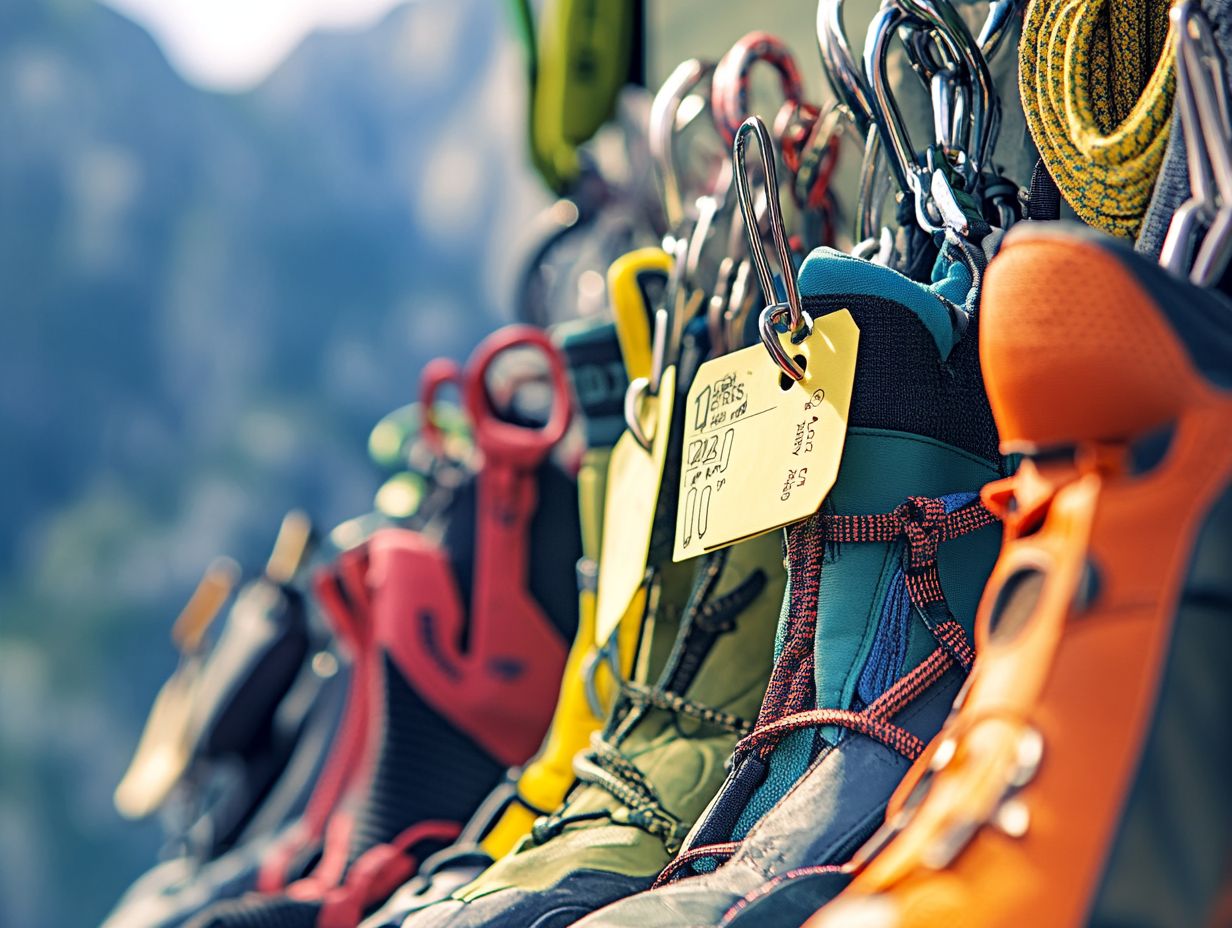
- Investing in quality climbing gear is crucial for safety and performance.
- The cost of climbing gear can vary based on materials, technology, and brand reputation.
- Consider buying used gear to save money, but prioritize safety and quality when making purchases.
The Importance of Quality Climbing Gear
Quality climbing gear is essential for both outdoor and indoor climbing, as it directly influences your safety and performance. By investing in premium equipment such as climbing harnesses, belay devices, and shoes, you equip yourself to approach various climbing disciplines with confidence.
The stark contrast between standard and premium gear can truly be the deciding factor between a triumphant ascent and a dangerous situation. The right climbing gear boosts your techniques and protects you from dangers.
Why Investing in Good Gear Matters
Investing in top-notch climbing gear isn’t merely a luxury; it s an essential component for both safety and performance in your climbing adventures.
When you engage in physically demanding and inherently risky activities, having the right equipment drastically minimizes the likelihood of accidents and injuries. For instance, high-quality climbing shoes offer superior grip and support, enabling you to tackle challenging routes with greater precision. Likewise, a reliable belay device ensures you can safely catch a fall, which can truly be a lifesaver in critical moments.
Think about the long-term benefits such as improved techniques, enhanced safety, and a more enjoyable climbing experience that make it a wise investment. Quality gear, including understanding the different types of climbing gear, not only bolsters your confidence but also promotes skill development, allowing you to climb at your best without the worry of gear failure or discomfort.
Essential Climbing Gear Types
Understanding the various types of climbing gear is crucial for any climber, whether you re scaling outdoor cliffs or tackling routes at a climbing gym. Each piece of equipment, from climbing packs to harnesses, serves a specific purpose that enhances both safety and performance.
Essential items like climbing shoes and belay devices are designed for different climbing disciplines, whether it s bouldering, sport climbing, or multi-pitch climbing. By choosing the right gear, you can significantly elevate your climbing experience and skills while minimizing risks.
Overview of Essential Gear
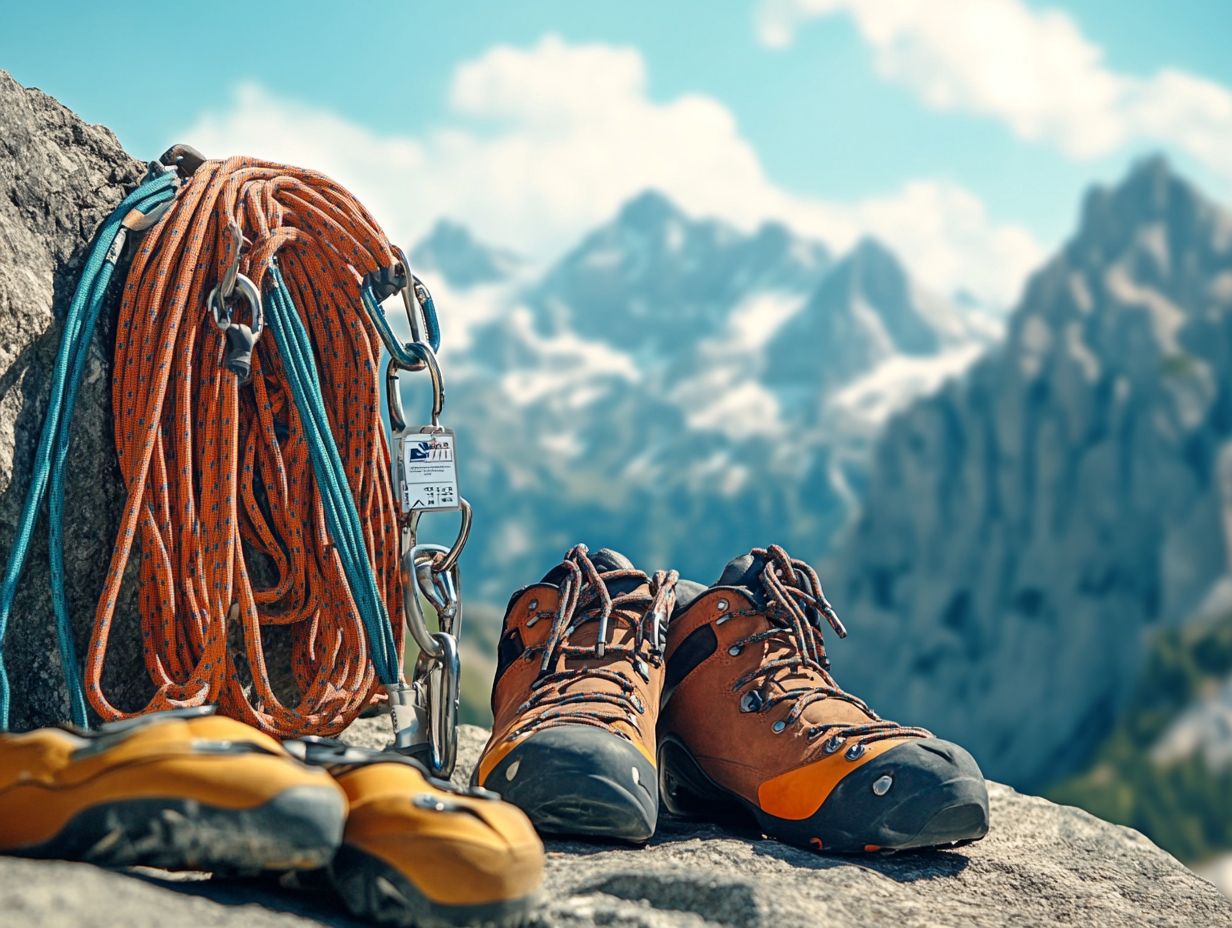
Essential climbing gear encompasses a range of items that are important for a safe and enjoyable climbing experience.
Among the most critical pieces is the crash pad, expertly designed to cushion falls during bouldering, providing a protective barrier against harsh impacts with the ground. Quickdraws are critical in sport climbing, enabling you to securely attach the rope to bolts while minimizing rope drag.
Ropes form another cornerstone of climbing safety; dynamic ropes are ropes that stretch to absorb the impact of a fall, while static ropes are ideal for techniques such as rappelling. Climbing harnesses offer a secure point of attachment, distributing the force across your body during falls or while suspended from a belay.
These essential items, tailored for specific climbing scenarios, work together to enhance both safety and performance as you navigate the vertical world.
Ready to gear up for your next climbing adventure? Check out our top recommendations!
Factors Affecting the Cost of Climbing Gear
The cost of climbing gear can fluctuate significantly, influenced by various factors such as materials, technology, and brand reputation. Additionally, whether you’re opting for new or used equipment can impact prices.
By grasping these nuances, you can make informed decisions that align with your budget while prioritizing safety and performance.
It’s important to note that high-quality materials often come with a higher cost. However, they deliver superior durability and performance especially for essential items like climbing shoes and belay devices.
Established brands usually cost more, reflecting their proven history of excellence in quality and safety.
Materials and Technology
The materials and technology in climbing gear are crucial in shaping your performance and safety as a climber.
High-quality synthetic fabrics like nylon and polyester provide remarkable durability and resistance to wear. This ensures your harnesses and ropes endure countless ascents without faltering.
Advanced composites, such as carbon fiber and Kevlar, significantly lighten your load while maintaining strength. You can carry less without sacrificing safety.
Premium gear often features state-of-the-art technologies, like dynamic belay devices devices that adjust how much friction is applied when catching a fall and climbing shoes crafted with specialized rubber compounds for optimal grip.
Together, these innovations enhance your performance and add a reassuring layer of security, boosting your confidence as you tackle challenging routes.
Brand and Reputation
Brand and reputation play a crucial role in the climbing gear market, where reputable brands consistently deliver equipment that adheres to rigorous safety standards.
When you choose gear from recognized brands, you’ll feel confident knowing your gear is top-notch. Brands like Petzl and Black Diamond boast rich histories of innovation and reliability, offering harnesses, carabiners, and ropes meticulously designed to tackle the unique challenges of climbing.
This level of trust not only bolsters your safety but can also enhance your performance on the rock. You can rely on gear that consistently performs well across various conditions.
By selecting trusted brands, you actively invest in your own safety, ensuring that every piece of gear is ready to meet the demands of your adventure.
Budgeting for Climbing Gear
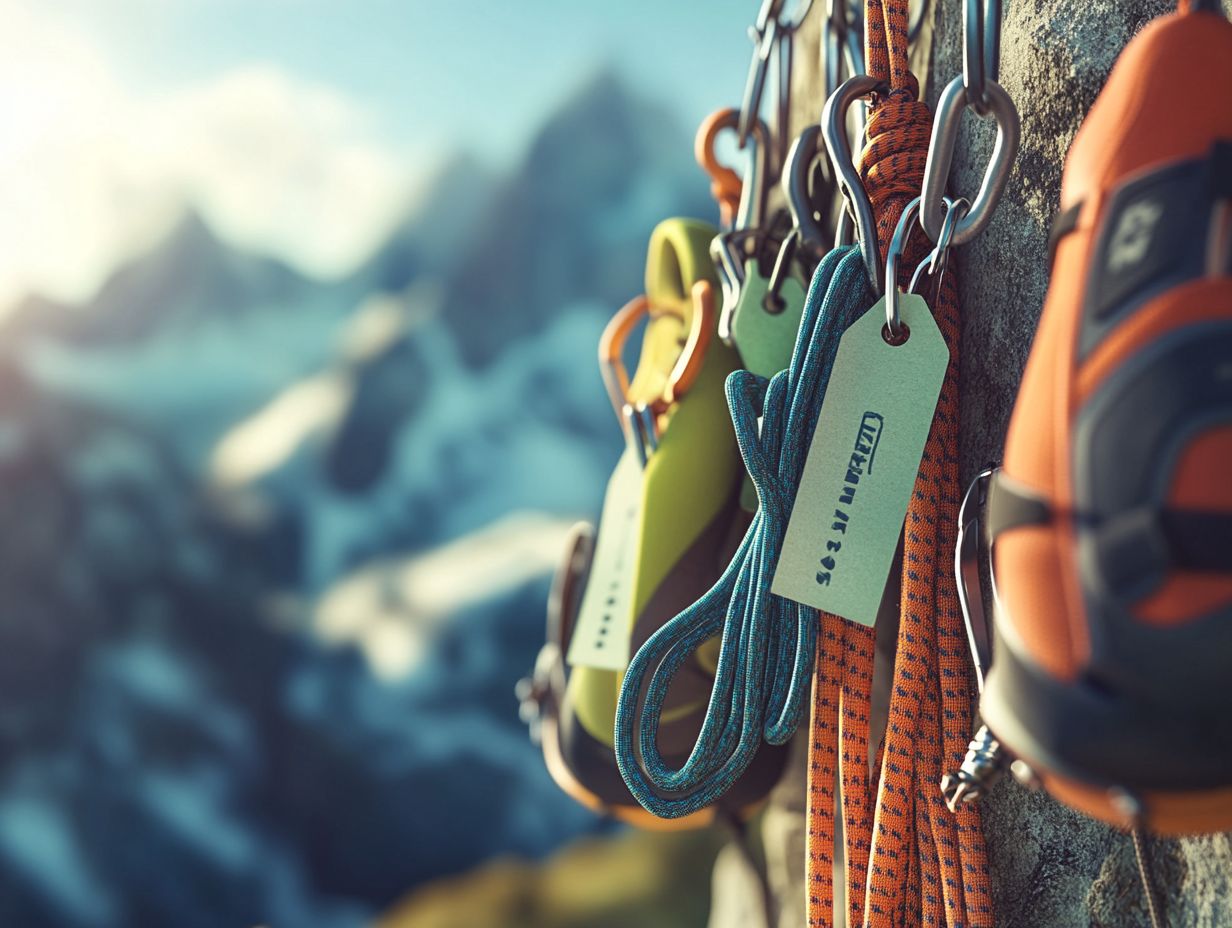
Budgeting for climbing gear is an essential task that empowers you to make informed decisions and strategic investments in your climbing journey. This allows you to strike a balance between quality and cost.
Tips for Saving Money
Saving money on climbing gear doesn t mean you have to compromise on quality. There are several effective strategies you can use to manage your gear investment wisely.
Consider exploring options like purchasing used equipment. Savvy climbers often discover high-quality items at a fraction of the retail price.
Websites and local gear swaps frequently offer gently-used gear that meets safety standards. This ensures you won t sacrifice performance for the sake of savings.
Timing your purchases around seasonal sales or promotional events can also lead to significant discounts on both essential and luxury items. Renting gear for those occasional climbs is another smart move, allowing you to access top-notch equipment without the hefty price tag of ownership.
Each of these methods not only helps you stay within your budget but also promotes a more sustainable approach to your climbing lifestyle.
Buying Used vs. New Gear
When you set out to acquire climbing gear, you’ll often find yourself weighing the choice between purchasing used or new equipment. Each option offers its own distinct set of advantages and disadvantages, making the decision an important one for your climbing journey.
Start your search for the best gear today!
Pros and Cons of Each Option
When considering purchasing climbing gear new or used it s crucial to weigh the pros and cons of each option. As you navigate the climbing gear market, take a moment to thoroughly evaluate factors such as cost, reliability, and safety.
New gear often includes the latest technology and enhanced durability, providing you with valuable peace of mind on your climbs.
However, the price can be quite steep, making it a significant investment. On the other hand, used gear offers a budget-friendly alternative, though you may encounter wear-and-tear that could impact its reliability.
If you decide to explore used options, be vigilant. Look for signs of damage, check expiration dates, and ensure that safety ratings which tell you how well the gear will protect you align with current standards. Additionally, understanding climbing gear weights is essential. This diligence will help guarantee that your climbing experience remains both safe and enjoyable.
Frequently Asked Questions
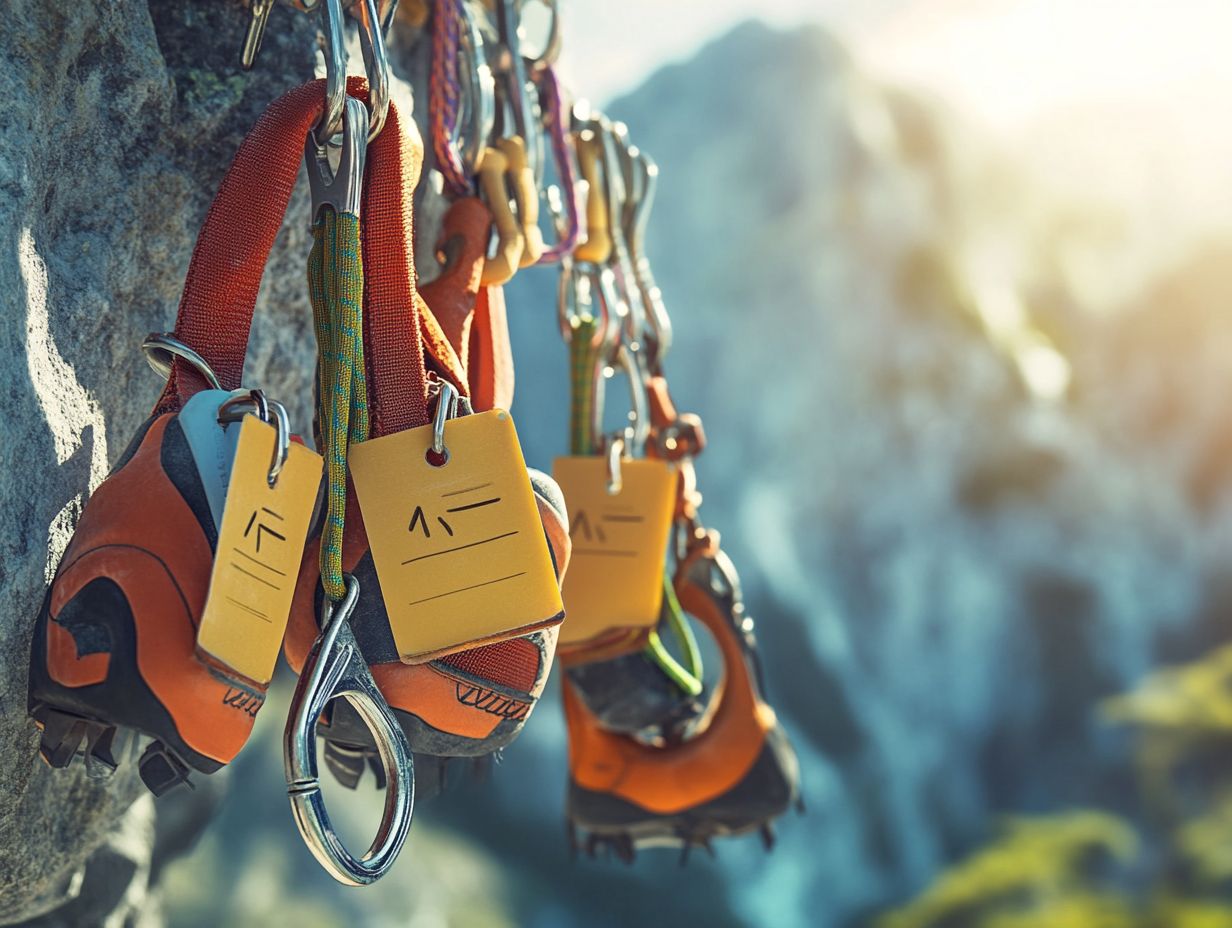
What factors contribute to the costs of climbing gear?
Climbing gear prices vary based on brand, materials, and technology. Other factors include the type of climbing (indoor vs. outdoor), level of durability and functionality, and demand for the gear.
Why are some climbing gear more expensive than others?
Some climbing gear can be pricier due to advanced features, specialized design, and high-quality materials. Brands also affect pricing, with some known for premium products and charging accordingly.
Is it worth investing in expensive climbing gear?
Investing in costly climbing gear can be worthwhile if you are a serious climber needing equipment that can withstand frequent, rigorous use. Expensive gear generally offers better quality and durability, crucial for safety and performance in the sport.
Can I find affordable climbing gear without sacrificing quality?
Yes! Affordable climbing gear options are available that still offer good quality and functionality. It s important to research and read reviews to ensure the gear meets safety standards and suits your climbing level.
Are there any ways to save money on climbing gear?
Absolutely! You can save money on climbing gear by buying second-hand items, taking advantage of sales and discounts, and purchasing in bulk. Focus on what you need most for your climbing style to save money!
How often should climbing gear be replaced?
Climbing gear should be replaced when it shows signs of wear and tear, damage, or if it has exceeded its recommended lifespan. Regularly inspect your gear and follow the manufacturer s guidelines for replacement to ensure safety while climbing.

